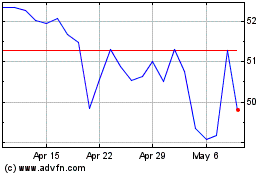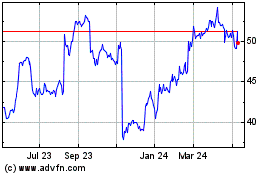Major Canadian Cities Continue to Struggle to Balance Burden Between Commercial and Residential Taxpayers
26 October 2022 - 11:32PM

Altus Group Limited (ʺAltus” or “the Company”) (TSX: AIF), a market
leading Intelligence as a Service provider to the global commercial
real estate industry, in partnership with the Real Property
Association of Canada (“REALPAC”), today released the 2022 Canadian
Property Tax Rate Benchmark Report which provides an in-depth look
at commercial and residential property tax rates in 11 major cities
across Canada.
Across Canada, all property owners pay tax based
on the assessed value of their property, but the tax rate per
dollar of property value varies depending on whether that property
is used for residential or commercial purposes. This report
examines how shifts in value between classes of property influence
tax increases with a spotlight on how municipal efforts to mitigate
tax increases can further contribute to inequities.
Commercial-to-residential tax
ratio
The commercial-to-residential tax ratio is the
key measure in the report that compares the commercial tax rate to
the residential tax rate. For example, if the ratio is 2.50, this
means that the commercial tax rate is two-and-a-half times (2.5x)
the residential tax rate.
The 2022 report found that seven out of the 11
cities surveyed have a commercial tax rate that is more than double
the residential tax rate, which means that a commercial property
incurs property taxes more than twice the amount of an equally
valued residential property. The average commercial-to-residential
tax ratio in 2022 was 2.80, reflecting a slight increase of 2.42%
from the 2021 average ratio of 2.73. The rise in the average ratio
was largely driven by the ratio increases in Calgary, Edmonton, and
Halifax, ranging from 6.5% to more than 10%.
|
Year-Over-Year Commercial-to-Residential Tax
Ratios |
|
City |
2022 |
2021 |
% Change 2021 to 2022 |
|
Montreal |
4.21 |
4.17 |
1.08% |
| Quebec
City |
3.51 |
3.47 |
1.30% |
|
Vancouver |
3.46 |
3.41 |
1.35% |
| Toronto |
3.36 |
3.44 |
-2.42% |
| Calgary |
3.07 |
2.78 |
10.27% |
| Halifax |
3.06 |
2.85 |
7.16% |
|
Average |
2.80 |
2.73 |
2.42% |
|
Edmonton |
2.68 |
2.52 |
6.53% |
| Ottawa |
2.39 |
2.37 |
0.95% |
|
Winnipeg |
1.92 |
1.93 |
-0.23% |
|
Saskatoon |
1.61 |
1.61 |
0.18% |
| Regina |
1.51 |
1.51 |
-0.09% |
“The post pandemic market is incredibly
volatile, and governments need to be proactive to address the value
shifts without increasing inequities between commercial and
residential taxpayers,” said Kyle Fletcher, President of Property
Tax Canada at Altus Group. “There are two factors that drive
property taxes – assessed values and municipal revenue
requirements. To achieve equitable taxation and to support economic
recovery, governments like Ontario’s need to embrace more frequent
reassessment to keep up with market changes, and municipalities
need to move away from policies that shift a greater portion of the
tax burden to commercial properties.”
Regional trend analysis
- Calgary observed
the largest commercial-to-residential ratio increase of the cities
surveyed, climbing 10.27% to 3.07. Continuing the trend since 2015,
the commercial assessment base contracted year-over-year due once
again to declining office assessment values, while the residential
assessment base experienced a notable increase of 8% year-over-year
due to a surging single-family market.
- Halifax made
positive changes in its ratio for 2021 taxation, but reversed
course for 2022. The Halifax Regional Municipality increased the
commercial tax rate and dropped the residential rate, resulting in
a 7.16% increase in its commercial-to-residential ratio, to
3.06.
- Edmonton faced
similar pressures to Calgary as a result of the latest
reassessment, causing its ratio to increase by 6.5% to 2.68.
- Vancouver saw a
decrease in both residential and commercial tax rates, reporting
the lowest rates of the cities surveyed. As the rate of taxation
for residential properties dropped further than the commercial
rate, its commercial-to-residential tax ratio increased by 1.35% to
3.46, ranking the third highest out of all cities surveyed.
- Quebec City first
climbed above the average in 2013 and remains well above the
average in 2022 with a ratio of 3.51.
- Montreal reduced
both residential and commercial tax rates in 2022, but a greater
reduction to residential resulted in a ratio increase of 1.08% to
4.21, continuing a four-year trend of posting the highest
commercial-to-residential ratio of all cities surveyed. With shifts
in assessment expected to occur with the 2023 triennial role, the
city will face pressure to further increase the commercial tax rate
relative to residential.
- Ottawa raised its
commercial rate by a greater percentage than residential, resulting
in a 0.95% increase to its ratio for the first time since 2017, now
sitting just below the national average at 2.39.
- Saskatoon and
Regina continued a six-year trend of posting a
ratio below 2.0 and remained static between 2021 and 2022 at 1.61
and 1.51, respectively, the lowest in the survey. Saskatchewan is
in the second year of its four-year assessment cycle and values
have not shifted.
- Winnipeg’s ratio
dropped slightly from 1.93 to 1.92 but would be above 2.20 if the
School Rebate and business tax were considered. It is anticipated
that the School Rebate will be increased for 2023, further widening
the gap between commercial and residential taxes.
- Toronto continued
to move toward tax equity, increasing the tax rate for residential
properties by a higher percentage than commercial. As a result, the
commercial-to-residential ratio continued its 18-year downward
trend and dropped by 2.42%, the most substantial reduction in the
survey.
Tax mitigation tools
New for 2022, the report provides a spotlight on
tax mitigation tools that are currently being implemented or
proposed across the cities surveyed. In response to sudden or
significant increases in tax burden, or for other policy reasons,
provincial or local governments may implement certain measures such
as assessment phase-ins, tax rate adjustments, capping or rebate
programs to impact the amount of taxes paid by a segment of
properties. The challenge with tax mitigation tools is that for
every property that benefits, another property must subsidize those
benefits.
A copy of the Altus Group 2022 Canadian Property
Tax Rate Benchmark Report can be downloaded at:
https://www.altusgroup.com/reports/canadian-property-tax-benchmark-report/
About Altus Group
Altus Group provides the global commercial real
estate industry with vital actionable intelligence solutions driven
by our de facto standard ARGUS technology, unparalleled asset level
data, and market leading expertise. A market leader in providing
Intelligence as a Service, Altus Group empowers CRE professionals
to make well-informed decisions with greater speed and scale to
maximize returns and reduce risk. Trusted by most of the world’s
largest CRE leaders, our solutions for the valuation, performance,
and risk management of CRE assets are integrated into workflows
critical to success across the CRE value chain. Founded in 2005,
Altus Group is a global company with approximately 2,650 employees
across North America, EMEA and Asia Pacific. For more information
about Altus (TSX: AIF) please visit altusgroup.com.
FOR FURTHER INFORMATION PLEASE
CONTACT:
Elizabeth Lambe Director, Global Communications,
Altus Group (416) 641-9787 Elizabeth.Lambe@altusgroup.com
Altus (TSX:AIF)
Historical Stock Chart
From Mar 2024 to Apr 2024

Altus (TSX:AIF)
Historical Stock Chart
From Apr 2023 to Apr 2024
